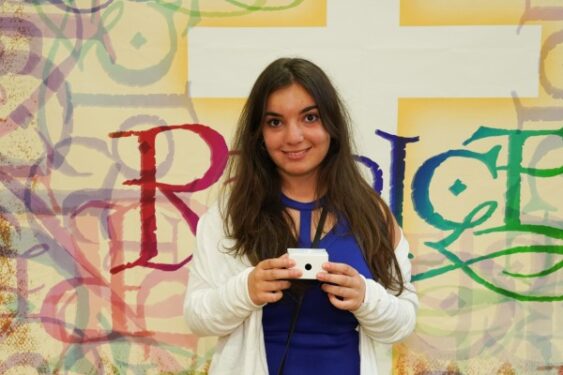
WINDSOR TERRACE — Instead of lying on the beach gazing at sunsets, a Holy Cross High School senior spent part of her summer closeted with a folder filled with mammary gland scans, as part of a unique science-based internship.
Through the Great Neck Breast Cancer Coalition (GNBCC)’s annual Students and Scientists Breast Cancer/Environment Research Program, Gabriella Aordkian worked online with Dr. Laura Vandenberg of the University of Massachusetts Amherst.
Vandenburg’s lab researches estrogenic chemicals in everyday products — such as personal care products, plastics, and food packaging — and their effects on the mammary gland in mice.
Aordkian juggled the month-long program with a full-time job over the summer. “I would get home from work, do an hour-long class with Vandenberg, and spend three hours just measuring the little mammary glands,” she said. “It was a lot of work, but it was a really cool experience.”
The path to pursuing breast cancer research through GNBCC began by chance, Aordkian explained.
After her summer 2020 internship with another Long Island-based program — which was supposed to focus on endometriosis — was canceled due to the pandemic, Aordkian decided to seek out any local mentors who would be willing to take her under their wing. But, after connecting with GNBCC President Laura Weinberg last year, breast cancer research soon became Aordkian’s primary focus.
“I always thought if someone gets breast cancer, it’s because it’s genetic,” Aordkian explained. “No one ever really talks about how chemicals can also increase the risk, especially during windows of conceptability.”
The goal for this year’s remote educational program, according to Vandenberg, was to have students learn about various topics relevant to breast cancer, breast health, environmental chemicals, and endocrine disruptors.
“I think that adolescents — and especially young women — should know about breast health and about the environmental influences that can impact their lives,” said Vandenberg, who has been hosting high school students through GNBCC for the last seven summers. “It is always such an incredible pleasure to work with young scholars and to get them the experience of working on research.”
“It wasn’t quite the same to have them work virtually both this year and last year,” she added, “but sometimes close is good enough.”
Using imaging software, Aordkian and five other high school students from the New York City area were able to analyze images of mammary glands collected from mice that had been exposed to chemicals when they were fetuses. They measured and compared structures within the mammary glands that are typically present during puberty, evaluating whether exposure to certain chemicals could put different generations of mice at a higher risk for cancer.
The group of high school students also interviewed experts, including advocates of breast cancer research. With the help of UMass Amherst undergraduates, the high school group created two podcast episodes about environmental chemicals and their effects on human health.
“How many people get to learn and know how to make a podcast?” Aordkian asked rhetorically with an excited tone.
At the end of August, Aordkian and the other high school students planned to translate their summertime research into action by presenting their findings to the GNBCC and local legislators. Aordkian also plans to continue her mentorship with Weinberg at GNBCC this academic year and is considering pursuing a pre-med track in college.
“It all worked out, in a sense, because Weinberg’s mentorship has brought me down so many paths that I could never have imagined myself going into,” Aordkian said. “I never thought I could ever speak at two legislator Zoom meetings in the spring, plus intern and work with Dr. Laura Vandenberg, while working all summer.”
